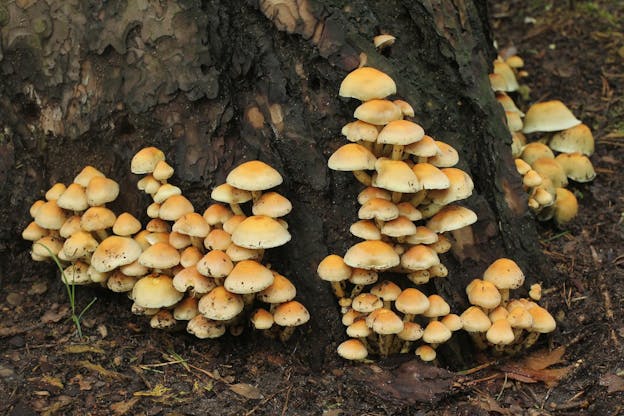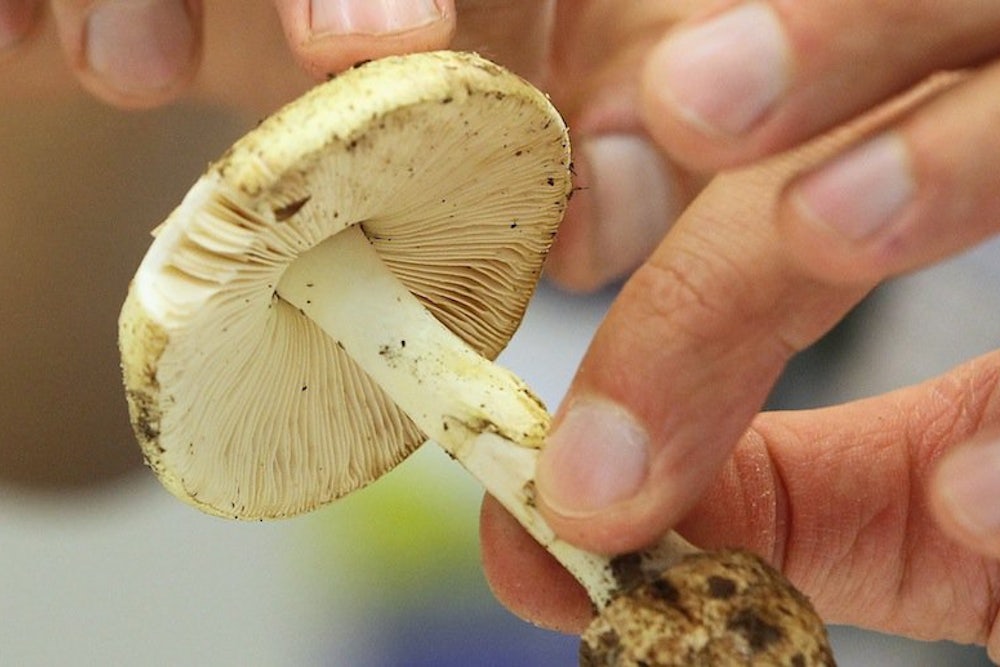Every age generates theories of nature that faithfully reflect its own preoccupations. Sometimes eagles and lions prove that God wants us to have kings; sometimes flowers prove that the world needs poets, or fruited plains are the sign of Manifest Destiny. So it is no surprise to meet a theory today that likes cooking, enjoys walks in the wood and artisanal hobbies, doubts humanity is really all that, and is quietly desperate to make some sort of peace with the perennial shit-storm of global capitalism.

Anna Lowenhaupt Tsing’s The Mushroom at the End of the World is a portrait of human relations with non-human species, specifically the matsusake mushroom, which grows in northern Europe, northeast Asia, and the Pacific Northwest, and is prized in Japan as a high-status delicacy that makes a refined gift. An anthropologist who has described mushrooms as “companion species,” she is interested in what people make of mushrooms—from sub-cultures and rituals to supply chains. She is also interested—sometimes playfully, sometimes a bit more seriously—in what mushrooms might make of us.
Tsing calls her book “a riot of short chapters … like the flushes of mushrooms that come up after a rain.” The book jumps among settings and themes. In logged-over American rain forests, we consider what mushroom foragers mean by “freedom” (mostly making money outside the nine-to-five). In Japan, we learn how the heavily used peasant forests around traditional villages, where matsusakes flourished, have become an ideal of pastoral nostalgia. We haggle with the middlemen who put foraged matsusakes onto international markets, and we are treated to extended riffs on mushroom biology, in which various strains of microbial life are so densely intertwined that the very idea of species boundaries comes into doubt.
From all this an argument emerges. Tsing wants to describe a post-Enlightenment natural world, one that can answer and support a new view of humanity. Tsing wants us to see everything in the living world as bound up together, like a mass of mushroom species, pine roots, nematodes, and soil chemicals. This, not some granite massif towering in a bright Alpine sky, should be our idea of what makes nature precious. And where John Muir and Teddy Roosevelt identified their true selves with that granite peak or with the aristocratic sequoia, we should honor our own hybrid origins and messy entanglements, from the half-wild and half-manufactured ecosystems that produce our food to the gut biomes that digest it and make each of us a metropolis of tiny life forms, a matsusake-like colony unto ourselves.
For Tsing, this aesthetics is also an ethics. She yokes the complexity and strangeness of ecology to her politics, which is pluralist, anti-hierarchical, suspicious of generalized programs, and committed to prizing the odd, marginal, and unexpected. This egalitarian, anti-systematic pluralism has been a major feature of the American cultural left, especially in the academy, for at least two generations now. It has real victories to its credit, notably the extraordinary flourishing of gender diversity that has followed rapidly on the successes of the gay-rights movement. At a time when nature itself seems ever more hybrid, impure, various, commingled—queer—this politics is now confecting a nature of its own. Maybe in time it will turn out as productive as the visions of nature that were symbiotic with the politics of John Locke, Henry David Thoreau, John Muir, and Teddy Roosevelt.
Tsing reserves special dislike for anything that makes the social or natural world more uniform and homogeneous. “Progress” is Sauron in Tsing’s telling. It doesn’t mean betterment, but rather implies bringing all creatures under the sway of one conceptual Ring of Power, subject to the same forces and principles, headed for the same historical destination. The protagonist of Progress was capital-M Man, master of capital-N Nature, who always bore a suspicious but unmentioned resemblance to an English gentleman, an American pioneer, or a Soviet proletarian. Acolytes of progress claimed to celebrate human freedom, but their one-size-fits-all approach eliminated freedoms that Tsing prefers: contingency, surprise, and diversity. This is why, she says, “all creatures can come back to life” once Man is gone, replaced by transient “assemblages” of species, cultures, and historical trajectories.
Tsing presents her approach as a big surprise for global capitalism, because she portrays capitalism as being imagined (by whom is never clear: bankers? start-up mavens? her fellow critical theorists?) to require standardization, uniformity, the reduction of all things into interchangeable commodities. She insists instead that real-life capitalism is entangled with strange, transient, semi-spontaneous “assemblages,” such as the supply chains of the matsusake mushroom. Market value comes not just from factories and plantations, but from odd places like semi-anarchic villages of mushroom foragers tucked into national forests. Trace global supply chains back far enough, and you end up in the queerest places. Some of the most productive mushroom patches appear, quite unplanned, in heavily logged forests, proof of what Tsing calls “the possibility of life in capitalist ruins.”

Indeed, we live in, and live on, ruins. Tsing wants us to pay more attention to “salvage capitalism,” in which markets do not produce goods through value-adding processes, but rip them from the spontaneous produce of the earth. Consider how much value comes from denuding forests, wearing out topsoil, fishing out the oceans. The extractive industries that still provide most of the world’s energy are making ruins from the strip mines of Appalachia to the climate-changed floodplains of Bangladesh.
But life in ruins, as self-exiled refugees, is still life. Tsing has unexpected praise for precarity, the insecurity that increasingly defines the world’s economies. A theory-head word for “precariousness,” precarity is usually a target for the left, implying as it does gig-based careers, no unions, uncertain pensions, and lifelong work and worry. Tsing argues that precarity also contains the seeds of a post-Man ethic. For her, a precarious situation has value that Thoreau would have recognized: it means “being vulnerable to others” and putting “unpredictable encounters at the center of things.” It means learning a heightened perceptiveness, whether scanning for economic opportunity or smelling a hint of matsusake in an Oregon forest and scanning the ground for the slight rise, like a curve of breathing chest, that indicates a mushroom may be rising there.
The argument is more than a mushroom will bear. Tsing’s portrayal of capitalism as sharing the spirit of a diverse, opaque, and not entirely rational nature is not the subversive surprise she seems to imagine. It is, rather, the mirror image of a dominant form of pro-market poetics. Tsing seems only slightly aware that her portraits of organic, spontaneous precarity would be entirely congenial to the professional celebrants of the current world economy.
Fans of markets no longer describe them as built from uniformity and standardization. When countercultural leftists were rejecting the regimentation of mid-century regulated capitalism, with its big companies, strong unions, and expectation of lifelong employment, the libertarian economist Friedrich Hayek was fomenting an intellectual rebellion against it. Hayek and his followers celebrated laissez-faire capitalism as an organic, spontaneous network of contingent assemblages, carrying diverse information across many heterogeneous settings and projects that no central planner or federal regulator could hope to encompass. The language of “natural capital” and “ecosystem services” that rules from law schools and environmental-policy programs to the Nature Conservancy and the “sustainability offices” of various corporations is totally congenial to Tsing’s picture, and vice-versa. The same Silicon Valley and business-school types who have turned “mindfulness” into a technique for raising productivity would love to celebrate precarity as a path to what Tsing calls “arts of noticing,” if they have not already.
As far as capitalism’s interaction with the natural world goes, Tsing’s perspective is almost all ethics and aesthetics, and hardly a politics at all. Centuries of politics have aimed at managing what Tsing optimistically calls “being vulnerable to others.” Tsing tells us chirpily that “Precarious living is always an adventure.” She is halfway right; sometimes an adventure becomes nightmare. Being epistemically, morally, or emotionally closed to others can be terrible; this is the focus of Tsing’s ethics of awareness. But being vulnerable to others, whether economically or in more immediate and violent ways, can be terrible, too. As for nature, the only thing worse than being closed to the natural world is being radically open to it—whether it is freezing you to death, tracking you as prey, or fatally infecting you.
We acquire the exquisite privilege of cultivating vulnerability only when we have first seen to one another’s security. This is a project of political economy, emphasis on political. An ethics of precarity is too close to taking art photographs of decay in a city we cannot save. Adam Smith, who was also interested in the naturalness of capitalism, once wrote that there is a lot of ruin in a country. The same goes for the world. It is too soon, and, more important, it surrenders too much, to make ruin our master-metaphor. The world still has a good deal of ruin in it, and, we can hope, plenty of fight as well.
